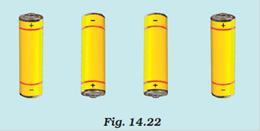Electric Current and its Effects - Solutions
CBSE Class–VII Science
NCERT Solutions
CHAPTER-14
Electric Current and its Effects
Question 1. Draw in your notebook the symbols to represent the following components of electrical circuits. Connecting wires, switch in the OFF position, bulb, cell, switch in ON position and battery.
Answer: Connecting wires 
Switch in the OFF position 
Bulb 
Cell 
Switch in ON position 
Battery 
Question 2. Draw the circuit diagram to represent the circuit shown in Fig. 14.3.
Answer:
Question 3. Fig. 14.4. Shows four cells fixed on a board. Draw lines to indicate how you will connect their terminals with wires to make a battery of four cells.
Answer:
Question 4.The bulb in the circuit shown in Fig. 14.5 does not glow. Can you indicate the problem? Make necessary changes in the circuit to make the bulb glow.
Answer: In the given circuit, the positive terminals of both the batteries are joined together so there is no flow of current and hence the bulb didn't glow.
Suggested changes: The current flows from positive terminals therefore the positive terminals of cell will be connected to negative terminal of the cell and vice versa.

Question 5. Name any two effects of electric current.
Answer: (i) Heating effect
(ii) Magnetic effect
Question 6. When the current is switched on through a wire, a compass needle kept nearby gets deflected from its north-south position. Explain.
Answer: When the current flows through a circuit produce magnetic field around it which deflect the needle of the compass kept nearby as it is also a piece of magnet.
Question 7. Will the compass needle show the deflection when the switch in the circuit shown by Fig. 14.24 is closed?.

Answer: No, the circuit is not having any source of electricity. Therefore, there will be no flow of electric current through and thus there will be no magnetic effect and neither the deflection of the needle.
Question 8. Fill in the blanks
(a) Longer line in the symbol for a cell represents its ----------------- terminal.
(b) The combination of two or more cells is called a--------------.
(c) When a current is switched ON in a room heater, it ----------.
(d) The safety device based on the heating effect of electric current is called a -----------.
Answer: Fill in the blanks
(a) Longer line in the symbol for a cell represents its positive terminal.
(b) The combination of two or more cells is called a battery.
(c) When a current is switched ON in a room heater, it produces heat.
(d) The safety device based on the heating effect of electric current is called a fuse.
Question 9. Mark ‘T” if the statement is true and ‘F’ if it is false:
(a) To make a battery of two cells, the negative terminal of one cell is connected to the negative terminal of other cell. (T/F)
(b) When the current through the fuse exceeds a certain limit, the fuse wire melts and breaks. (T/F)
(c) An electromagnet does not attract a piece of iron. (T/F)
(d) An electric bell has an electromagnet. (T/F)
Answer: (a) F (b) T (c) F (d) T
Question 10. Do you think an electromagnet can be used for separating plastic bags from a garbage heap? Explain.
Answer: No, electromagnets attract only the magnetic material like iron. So, it
cannot be used for separating plastic from garbage.
Question 11. An electrician is carrying out some repairs in your house. He wants to replace a fuse by a piece of wire. Would you agree? Give reasons for your response.
Answer: Replacing the fuse with metal piece should be dangerous as fuse wire have very low melting point. In case of metal piece the melting point will be high and circuit will be not prevented in case of overloading or overheating.
Question 12. Zubeda made an electric circuit using a cell holder shown in Fig. 14.4, a switch and a bulb. When she put she switch in the ON position, the bulb did not glow. Help Zubeda in identifying the possible defects in the circuit.
Answer: Possible defect:
(i) Bulb may have fused.
(ii) Rubber band of cell holder may not be tight and connections are loose.
(ii) Terminals of the cells may not be in the correct positions.
Question 13. In the circuit shown in Fig. 14.25

(i) Would any of bulb will glow when the switch is in the ‘OF’ position?
(ii) What will be the order in which bulb A, B, C will glow when switch is moved to the ‘ON’ position?
Answer: (i) No, none of the bulb will glow when the switch is in the ‘OFF’ position.
(ii) All the bulbs will glow at once because connections are ok.
